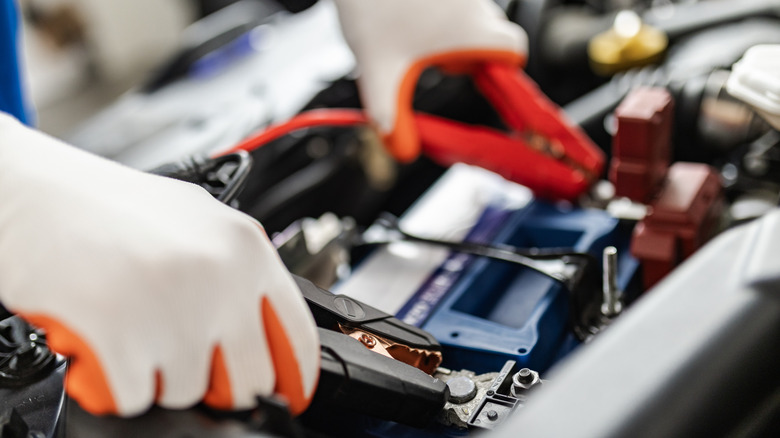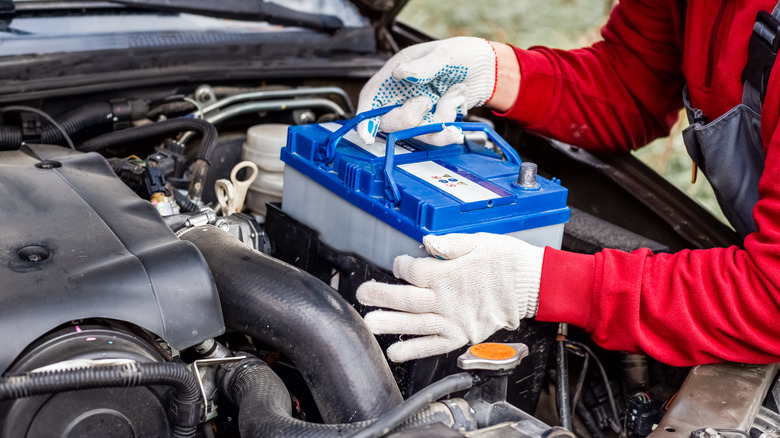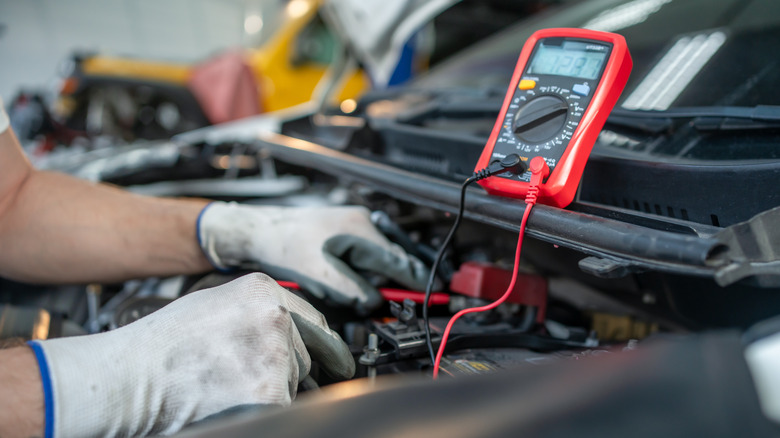Do You Need A New Car Battery, Or Just A Jump? Here's An Easy Way To Tell
So you're planning to visit your family for the weekend. You've already packed your stuff in the trunk, and your tank is full. Now you're thinking nothing could go wrong during your interstate drive. But as soon as you turn your key — or push the button — all you hear is a rapid clicking sound as the ignition fails to start. When this happens, it's common to think your battery might be on its last legs, but how will you know if it only needs a quick jump or a replacement altogether?
Before jumping to conclusions, you first need to consider the age of your car's battery. According to the American Automobile Association (AAA), a battery's lifespan can range from three to five years. However, just because it's fairly new, it doesn't mean that it only needs a jump to work again. A car battery can die overnight even when everything is turned off due to a parasitic draw.
Perhaps you always forget to turn off your headlights or radio before shutting off the car. Driving habits, a malfunctioning charging system, too much vibration, and the weather outside can also affect the lifespan of your battery, with the AAA noting that car batteries in hot places are likely to last shorter than those in cold regions.
Signs your car's battery has seen better days
Way before your car reaches the point when it can no longer start the ignition, it will show signs of dwindling battery capacity. The most obvious of which is when the battery light on the dashboard switches on. Sure, there are many reasons for the battery light to come on. However, when all of those possibilities do not tick the box, the only thing left to accept is that your car's battery is either old and worn out, or completely dead.
Apart from the warning light, another tell-tale sign is when the headlights become dimmer, especially when the car is idling. Sluggish engine cranks manifested in slow and problematic startups also confirm what you suspect, along with a faint rotten egg smell coming from under the hood. Visually, a failing battery may appear swollen.
The swelling is typically caused by overcharging due to a malfunctioning alternator. Corrosion on the battery terminals is also a hint. Additionally, if you previously jumped the battery for your car to start but the vehicle quickly died, that's the clearest sign that your battery no longer holds a charge and should be replaced immediately.
When to jumpstart and when to replace your car's battery
Newer cars are equipped with advanced onboard diagnostic systems that eliminate the guesswork when determining if the battery needs a replacement. For people driving older models, they need to rely on visible signs that it's time to replace the car battery, such as the ones mentioned before — a deformed or swollen casing, difficulty starting the car, and weak electrical current for the headlights and other features, such as power windows.
However, if you really want to figure out what you're dealing with, you can try using a multimeter, an electronic measuring device used to test and measure current and other electrical properties of a circuit. A fully charged car battery should read around 12.6 volts or higher. Anything lower suggests a weak or dead battery. Interestingly, even with a low output, dead car batteries can still be recharged.
Still, it's better to buy a new one at that point, since the capacity of older batteries starts to deteriorate after years of use. Recharging will only extend your battery's lifespan for a short period, and the disappointment you'll feel will be twice as much the next time you get stranded again after hearing the familiar clicking noise as you turn your key in the ignition.


